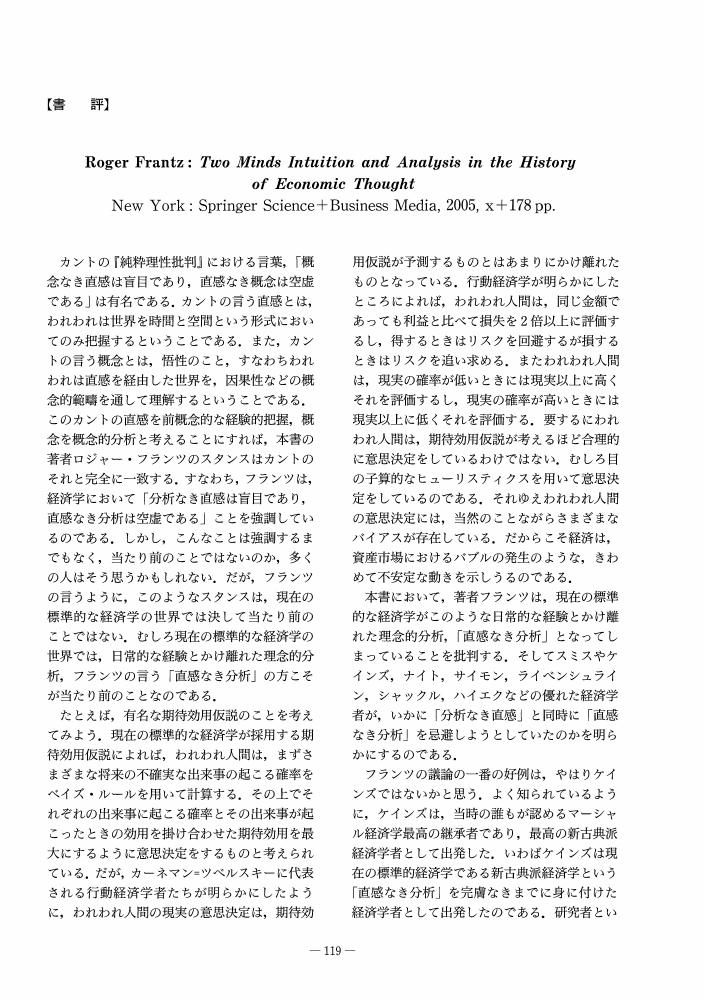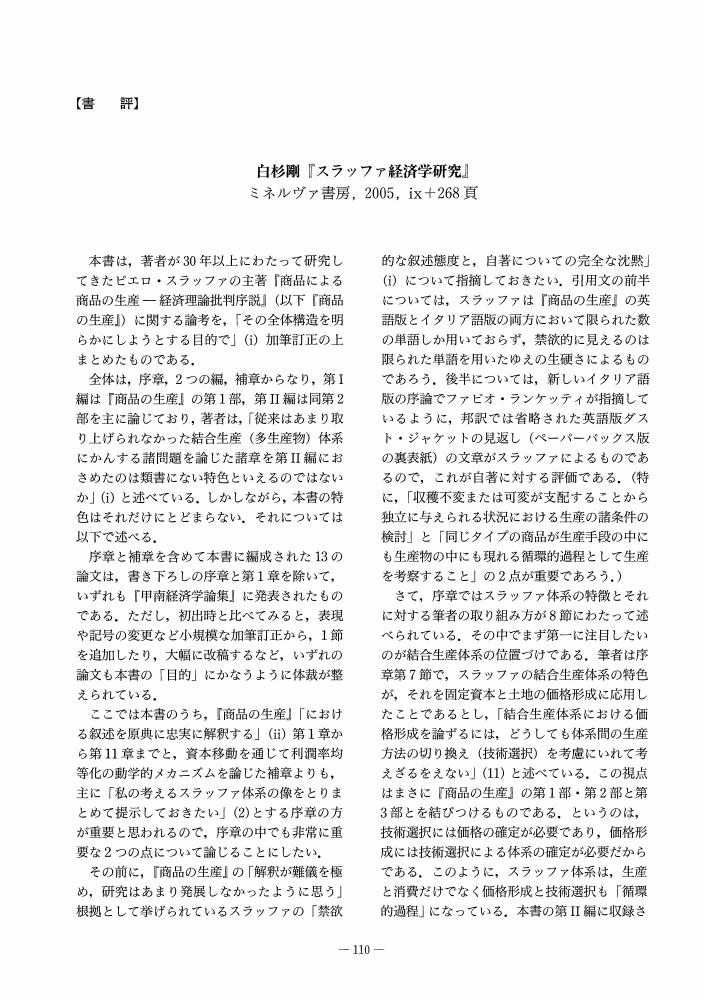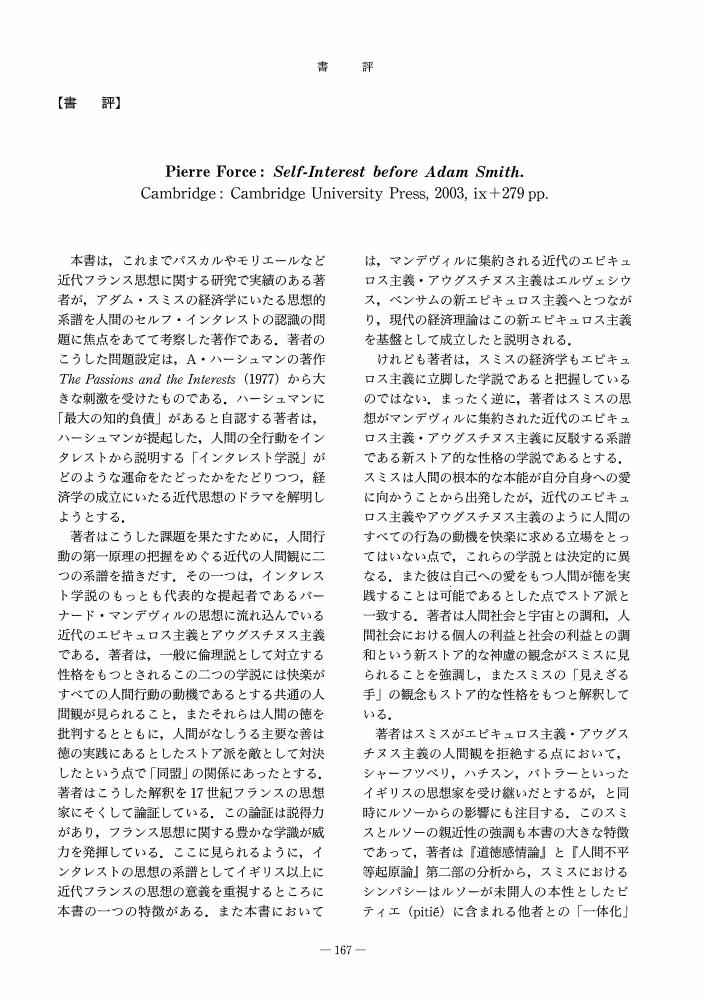1 0 0 0 OA R. トレンズの投下労働価値論批判
- 著者
- 久松 太郎
- 出版者
- The Japanease Society for the History of Economic Thought
- 雑誌
- 経済学史研究 (ISSN:18803164)
- 巻号頁・発行日
- vol.49, no.1, pp.37-52, 2007-06-30 (Released:2010-08-05)
- 参考文献数
- 45
Ricardo redesigned the labour theory of value in his Principles, which was published in 1817. Robert Torrens produced numerous works (1818, 1821, 1822a, 1822b, 1822c, 1829) and “Fragments on Torrens Concerning Value” (1818, in the Works of David Ricardo, IV), but as early as 1818 he was already attempting to refute Ricardo's theory by proposing his own “capital theory of value.” This paper focuses on Torrens's refutation of the Ricardian labour theory of value and considers the several numerical examples he employed in his refutation.There is general consensus on two points in particular regarding Torrens's theory of value: first, his capital theory of value was just another representation of the labour theory of value, and second, his refutation of the Ricardian labour theory of value is valid to a certain extent. This paper scrutinizes the process through which many commentators on Torrens's theory of value have reached their conclusions, although it does not find any objections to those conclusions.Torrens based each of his works on different definitions of “labour, ” which lets us understand the various ways in which the embodied concept of “labour” can be reckoned. With each successive work, noted above, Torrens corrected mistakes in previous works. This paper begins by building models based on his last numerical example, given in Corn Trade (1826-29), and then shows the process of his corrections. In this way we can reestablish the limits of his refutation of the labour theory of value and of his own value theory, making possible the argu ment that he would play the role of Auflösung der Ricardoschen Schule.
- 著者
- 森村 敏己
- 出版者
- 経済学史学会
- 雑誌
- 経済学史研究 (ISSN:18803164)
- 巻号頁・発行日
- vol.48, no.2, pp.114-115, 2006-12-20 (Released:2010-08-05)
- 著者
- 安井 俊一
- 出版者
- The Japanease Society for the History of Economic Thought
- 雑誌
- 経済学史研究 (ISSN:18803164)
- 巻号頁・発行日
- vol.48, no.2, pp.116-118, 2006-12-20 (Released:2010-08-05)
- 著者
- 荒川 章義
- 出版者
- The Japanease Society for the History of Economic Thought
- 雑誌
- 経済学史研究 (ISSN:18803164)
- 巻号頁・発行日
- vol.48, no.2, pp.119-120, 2006-12-20 (Released:2010-08-05)
- 著者
- 田中 秀夫
- 出版者
- The Japanease Society for the History of Economic Thought
- 雑誌
- 経済学史研究 (ISSN:18803164)
- 巻号頁・発行日
- vol.48, no.2, pp.121-122, 2006-12-20 (Released:2010-08-05)
- 著者
- 中澤 信彦
- 出版者
- The Japanease Society for the History of Economic Thought
- 雑誌
- 経済学史研究 (ISSN:18803164)
- 巻号頁・発行日
- vol.48, no.2, pp.123-124, 2006-12-20 (Released:2010-08-05)
- 著者
- 熊谷 次郎
- 出版者
- The Japanease Society for the History of Economic Thought
- 雑誌
- 経済学史研究 (ISSN:18803164)
- 巻号頁・発行日
- vol.48, no.2, pp.125-126, 2006-12-20 (Released:2010-08-05)
- 著者
- 原田 哲史
- 出版者
- The Japanease Society for the History of Economic Thought
- 雑誌
- 経済学史研究 (ISSN:18803164)
- 巻号頁・発行日
- vol.48, no.2, pp.127-129, 2006-12-20 (Released:2010-08-05)
- 著者
- 内藤 敦之
- 出版者
- The Japanease Society for the History of Economic Thought
- 雑誌
- 経済学史研究 (ISSN:18803164)
- 巻号頁・発行日
- vol.48, no.2, pp.130-131, 2006-12-20 (Released:2010-08-05)
- 著者
- Lawrence Wilde
- 出版者
- The Japanease Society for the History of Economic Thought
- 雑誌
- 経済学史研究 (ISSN:18803164)
- 巻号頁・発行日
- vol.48, no.2, pp.132-133, 2006-12-20 (Released:2010-08-05)
1 0 0 0 OA R・オウエンとJ・ウォレンの労働証券論
- 著者
- 結城 剛志
- 出版者
- The Japanease Society for the History of Economic Thought
- 雑誌
- 経済学史研究 (ISSN:18803164)
- 巻号頁・発行日
- vol.48, no.2, pp.19-35, 2006-12-20 (Released:2010-08-05)
- 参考文献数
- 26
In the early nineteenth-century, attempts were made to apply the labor theory of value in transactions based on “labor notes, ” or certificates obliging the bearer to perform labor in exchange for goods. Robert Owen (1771-1858) and Josiah Warren (1798-1874) both made such attempts. This paper is a comparative study of the ideas on labor notes in the theories of Robert Owen and Josiah Warren. Considerable research has been done on labor note theory, but so far the thinking of Warren and his experiments in the United States have received relatively little attention. My purpose here is to clarify the ideas of Warren in their theoretical and practical dimensions and compare them with those of Owen.Three factors may account for the still inadequate research on Warren's theory and its relation with Owen's theory. First, Marxist theory rejects the practice of labor notes as unfeasible, and considers the theory behind them to be “utopian” Second, contemporary research is affected by the failure of Owen's projects at New Harmony (1825-27, Indiana) and the National Equitable Labour Exchange (1832-34, London). This is the state of affairs in nineteenth-century English discourse. Third, most studies dealing with the theory behind labor notes are chiefly biographical treatments of Owen, despite the fact that Warren participated in New Harmony, and it influenced the development of his unique theory. In resuscitating Warren's ideas, specifically his labor notes theory, I propose that they represent a forgotten stage in nineteenth-century American thought, and for that reason merit serious study.In order to shed light on Warren's theory and that ‘forgotten stage, ’ I examine the relationship of Owen and Warren in New Harmony from four perspectives: their ideas and practices regarding forms of ownership; the problem of evaluating labor time; how to issue labor notes; and the relationship between price as a function of labor time and price as a representation of monetary value.
1 0 0 0 OA ジョン・バートンにおける機械と失業
- 著者
- 石井 穣
- 出版者
- The Japanease Society for the History of Economic Thought
- 雑誌
- 経済学史研究 (ISSN:18803164)
- 巻号頁・発行日
- vol.48, no.2, pp.36-50, 2006-12-20 (Released:2010-08-05)
- 参考文献数
- 28
In his 1817 pamphlet on the conditions of the laboring classes, John Barton (1789-1852) argued that the introduction of machinery would reduce the demand for labor not only when the amount of capital was held constant, but also in the case of capital accumulation. Schumpeter noted that Barton surpassed the other classical economists in his recognition of the substitutability of capital for labor, but Schumpeter's interpretation could lead to the conclusion that Barton did not intend to show that a reduction in the demand for labor would occur as a consequence of the introduction of machinery. This paper examines the assumptions behind Schumpeter's perspective and investigates theoretical problems in Barton's argument.In his treatment of factor substitution, Barton reasoned that all laborers displaced by machinery would soon find jobs as real wages fell. As for the accumulation of capital, in Barton's analysis additional capital in the form of machinery would be introduced in response to higher real wages, leading to a reduction in the wage share of total income.The letter he received from Ricardo on 20 May 1817 led Barton to consider that introducing machinery would bring about a reduction in the demand for labor even when the amount of capital was increased. However, he was not able to distinguish the effect of machinery from the effect of capital accumulation on employment.Though there were theoretical problems in Barton's attempt to show the effects of the introduction of machinery on employment, his thinking on machinery was later developed by Marx into the theory of an industrial reserve army of labor.
1 0 0 0 OA ケンブリッジ・ネットワーク
- 著者
- 久保 真
- 出版者
- The Japanease Society for the History of Economic Thought
- 雑誌
- 経済学史研究 (ISSN:18803164)
- 巻号頁・発行日
- vol.48, no.2, pp.67-83, 2006-12-20 (Released:2010-08-05)
- 参考文献数
- 98
This article is a survey of recent studies concerning W. Whewell, R. Jones, C. Babbage, and others in the Cambridge network. These were the Cantabrigians who launched the methodological attack on Ricardian, or orthodox, political economy, and historians of economics have lumped them together as the Cambridge inductivist group. Work in the history of science, however, has long established that the members of this “group” were by no means in full accord regarding methodology. Whewell, in fact, the pivotal figure in the network, did not follow an inductivist approach in his scientific methodology. Recently scholars have begun to recognize that each of the several methodological approaches represented in the group deserves its own distinct place in the history of economics.Why did the Cantabrigians join forces to undermine orthodoxy and attempt to form an alliance with Malthus, even though their methodological views were, to one degree or another, at variance? Various explanations have been proposed, and although there is still no consensus on the answer, the dispute itself is proving to be productive, perhaps more so than the arguments centering on the methodology.While their attacks on classical orthodoxy have been studied in some detail, the kind of economics the Cantabrigians taught and were taught have received less attention from researchers. It has been often assumed, for example, that Pryme, the first professor of the subject at the university, was a minor follower of Whewell. Recent findings, however, suggest that he was primarily a disciple of orthodoxy, and possibly an adversary of Whewell, Jones, and Babbage, all of whom had visions of the coming industrial society as technology-driven and class-harmonious.Some recent studies indicate that the anti-Ricardian academics not only had lasting influence on the university (in spite of Pryme) and the East India College, but also upon newly established societies for economic research. A more complete understanding of their influence will shed new light upon what is called the Decline of Ricardian Economics and the emergence of Jevonsian and Marshallian economics.
- 著者
- Tatsuro Kanai
- 出版者
- The Japanease Society for the History of Economic Thought
- 雑誌
- 経済学史研究 (ISSN:18803164)
- 巻号頁・発行日
- vol.48, no.2, pp.84-97, 2006-12-20 (Released:2010-08-05)
- 参考文献数
- 12
- 著者
- 若田部 昌澄
- 出版者
- The Japanease Society for the History of Economic Thought
- 雑誌
- 経済学史研究 (ISSN:18803164)
- 巻号頁・発行日
- vol.48, no.2, pp.98-101, 2006-12-20 (Released:2010-08-05)
- 参考文献数
- 9
- 著者
- 小峯 敦 服部 茂幸 木村 雄一 山崎 聡
- 出版者
- The Japanease Society for the History of Economic Thought
- 雑誌
- 経済学史研究 (ISSN:18803164)
- 巻号頁・発行日
- vol.48, no.2, pp.102-107, 2006-12-20 (Released:2010-08-05)
- 参考文献数
- 13
1 0 0 0 OA 白杉剛『スラッファ経済学研究』ミネルヴァ書房, 2005, ix+268頁
- 著者
- 藤井 盛夫
- 出版者
- 経済学史学会
- 雑誌
- 経済学史研究 (ISSN:18803164)
- 巻号頁・発行日
- vol.48, no.2, pp.110-111, 2006-12-20 (Released:2010-08-05)
- 著者
- 水田 健
- 出版者
- 経済学史学会
- 雑誌
- 経済学史研究 (ISSN:18803164)
- 巻号頁・発行日
- vol.48, no.2, pp.112-113, 2006-12-20 (Released:2010-08-05)
- 著者
- 板井 広明
- 出版者
- The Japanease Society for the History of Economic Thought
- 雑誌
- 経済学史研究 (ISSN:18803164)
- 巻号頁・発行日
- vol.48, no.1, pp.164-166, 2006-06-30 (Released:2010-08-05)
- 著者
- 八幡 清文
- 出版者
- The Japanease Society for the History of Economic Thought
- 雑誌
- 経済学史研究 (ISSN:18803164)
- 巻号頁・発行日
- vol.48, no.1, pp.167-169, 2006-06-30 (Released:2010-08-05)















